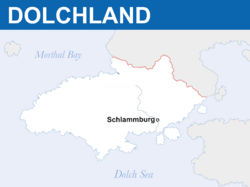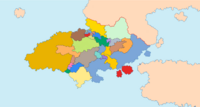Dolchland: Difference between revisions
No edit summary |
|||
| Line 88: | Line 88: | ||
==Culture== | ==Culture== | ||
(Music and Art. Cuisine. Sports.) | (Music and Art. Cuisine. Sports.) | ||
===Cuisine=== | |||
Historically, a staple part of the Dolchlander diet was ''Müd'', a thick rye and beetroot soup or stew. It was eaten by almost all of the strata of Dolchlander society, from the lower classes and to even the aristrocracy. Although often considered bland and having something of an earthy flavour, it often had various meats and other vegetables added, depending on season or availability. It has been replaced by other starches, such as the potato, in more recent years but it remains a key part of Dolchlander identity, one that spreads across all of the states of the country. There are several regional variations, such as the ''schollemüd'', made with fried fillets of Dolchic plaice and eaten in eastern Panedonia or ''hügelmüd'', a variety made with smoked cheese and typically eaten in the hilly north of Wuveria. Similar variations, referred to as ''käsemüd'' are found across the upland regions of the country. However, the basic recipe remains the same across Dolchland. | |||
It is thought that the soup inspired the pegorative term for Dolchlanders, "mud-" or "dirt-eater". Foreigners to the country would see the locals tucking into bowls of thick, brown soup and see a likeness to the thick, brown mud of the fertile lands of Dolchland. It is a term that is generally used to portray the Dolchlanders as an ignorant, backward people. This flies in the face of the history as a land of explorers and settlers, although it has been suggested that one of the reasons that they spread so far was to find better things to eat. | |||
{{Eurth}} | {{Eurth}} | ||
[[Category:Dolchland]] | [[Category:Dolchland]] | ||
Revision as of 20:50, 26 October 2021
This article is incomplete because it is pending further input from participants, or it is a work-in-progress by one author. Please comment on this article's talk page to share your input, comments and questions. Note: To contribute to this article, you may need to seek help from the author(s) of this page. |
Empire of Dolchland Dolchland | |
|---|---|
 Map of Dolchland | |
| Capital | Schlammburg |
| Largest city | Morthal |
| Official languages | Alemannisch |
| Government | Elective Monarchy |
• Emperor | Heinrich Johannes von Fleischmann |
| Legislature | Imperial Diet |
| Diet of Electors | |
| Establishment | |
• Establishment of the Empire | 1777 |
| Population | |
• 2018 estimate | 29,283,179 |
| GDP (nominal) | 2018 estimate |
• Total | $289,991,321,637 |
• Per capita | $9,903 |
| HDI | .600 medium |
| Currency | Thaler |
Dolchland is a country located in South East Argis. It's closest neighbours are Seylos and Ceris to the south, Velaheria to the north, Stedoria to the north west, and Delamaria and Fravina to the north east. The capital of Dolchland is Schlammburg, however the largest city is Morthal. The nation has a population of 28 Million, divided among its 40 constituent states. With varying degrees of power and importance, Dolchland's constituent states are fairly independent, with only a common Emperor, external foreign policy and law to unite them. Individual states usually maintain their own militaries and are almost all hereditary monarchies.
Dolchland has declined in recent decades, with a low gdp per capita, and widespread inequality between the ruling aristocracy and the common people. There have been several attempted revolutions in Dolchland's history, however most have been put down with force. Democratic parties are present in most states of the empire, however they are banned in some regions, and where they are allowed they are subject to constant raids and abuse by the local governments.
Etymology
(WIP. German for 'Daggerland'.)
Geography
(WIP. Climate. Environment.)
The country's geography is vast and varied with some areas being extremely mountainous, others being noxious bogs, and others being old forests from before the time of man. Of note, only the southern parts of the country have somewhat mild summers and winters. The rest of the country tends towards mild summers and harsh winters, with snowfall and thick freezing fog being a constant issue for much of the year. Due to its geographical location, much of the Æitiastain region suffers from thick rolling fog, near constant rain, and thunderstorms during the fall wet season. This is caused by warm and wet air being forced above cooler air by storm systems coming off of the Adlantic. The resulting pressure and potential differentials lead to electrostatic discharges being rather common for the season and cool air filled with moisture condensing near the ground.
Special note should be given to the mountain range in the north of the country. The Apf Kadirn-Gebirge are truly massive, with the largest mountain in the world, Jokultitbjarg, rising in them. They are of quite a large amount of historical importance, as wars have been won and lost over the control of passages through them.
History
Politics
(Government. Law. Military. Foreign Relations. Dolchland is an elective monarchy, meaning that when the reigning emperor dies, the Diet of Electors is called to elect a new head of state. The members of the Diet are the monarchs and leaders of Dolchland's constituent states, each with varying amounts of votes in the election depending on the size and power of their domain. The current Emperor is His Imperial Majesty, Heinrich Johannes von Fleischmann, the brother of the King of Habstria and nephew of the previous emperor Friedrich Johannes von Fleischmann. The Ausburg-Fleischmann Dynasty has ruled for $Years years, projecting Habstrian power across the empire, however other kingdoms have become increasingly aligned with one another, especially Panedonia, threatning the power of the Habstrian kings over the Imperial throne.
The empire consists of 5 Kingdoms, 13 Duchies, Landgravites and Electorates and 9 Baronies.
Economy
(Energy. Industry. Infrastructure. Transport.)
Demographics
(WIP. Language: Alemannisch. Education. Religion.)
Culture
(Music and Art. Cuisine. Sports.)
Cuisine
Historically, a staple part of the Dolchlander diet was Müd, a thick rye and beetroot soup or stew. It was eaten by almost all of the strata of Dolchlander society, from the lower classes and to even the aristrocracy. Although often considered bland and having something of an earthy flavour, it often had various meats and other vegetables added, depending on season or availability. It has been replaced by other starches, such as the potato, in more recent years but it remains a key part of Dolchlander identity, one that spreads across all of the states of the country. There are several regional variations, such as the schollemüd, made with fried fillets of Dolchic plaice and eaten in eastern Panedonia or hügelmüd, a variety made with smoked cheese and typically eaten in the hilly north of Wuveria. Similar variations, referred to as käsemüd are found across the upland regions of the country. However, the basic recipe remains the same across Dolchland.
It is thought that the soup inspired the pegorative term for Dolchlanders, "mud-" or "dirt-eater". Foreigners to the country would see the locals tucking into bowls of thick, brown soup and see a likeness to the thick, brown mud of the fertile lands of Dolchland. It is a term that is generally used to portray the Dolchlanders as an ignorant, backward people. This flies in the face of the history as a land of explorers and settlers, although it has been suggested that one of the reasons that they spread so far was to find better things to eat.



